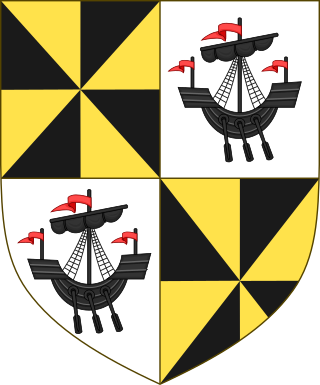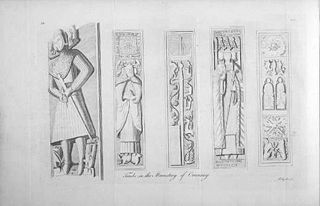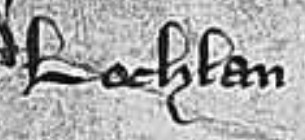Related Research Articles

Clan Campbell is a Highland Scottish clan, historically one of the largest and most powerful of the Highland clans. The Clan Campbell lands are in Argyll and within their lands lies Ben Cruachan. The chief of the clan became Earl of Argyll and later Duke of Argyll.

Colin Campbell, 1st Earl of Argyll was a medieval Scottish nobleman, peer, and politician. He was the son of Archibald Campbell, Master of Campbell and Elizabeth Somerville, daughter of John Somerville, 3rd Lord Somerville. He had the sobriquet Colin Mulle, Bold Earl Colin.
The Lord Chancellor of Scotland, formally the Lord High Chancellor, was a Great Officer of State in the Kingdom of Scotland.
Cailean Mór Caimbeul is one of the earliest attested members of Clan Campbell and an important ancestor figure of the later medieval Earls of Argyll.
Gille Escoib or Gilleasbaig of Menstrie is the earliest member of the Campbell family to be attested in contemporary sources, appearing in royal charters dating to the 1260s. His existence is confirmed by later Campbell pedigrees. According to these genealogies, he was the son of a man named Dubhghall ("Dugald"). However, nothing is known of this man, nor of the 4 or 5 generations of his ancestors who constitute the probable historical section these genealogies preceding Dubhghall. Gilleasbaig's first historical appearance dates to 1263, when he appeared in a charter of King Alexander III of Scotland, being named as "Gilascoppe Cambell". He was granted the estates of Menstrie and Sauchie in Clackmannanshire. His next appearance, and indeed his final appearance, is in 1266, when he witnessed another royal charter at Stirling granting favours to Lindores Abbey. The genealogies, and indeed later 13th century patronymic appellations, tell us that Gilleasbaig was the father of Cailean Mór, probably by marriage to the Carrick noblewoman, Afraig, a daughter of Cailean of Carrick.
Cailean of Carrick or Cailean mac Donnchadh was the son of Donnchadh, Earl of Carrick, and probably the father of Niall, Earl of Carrick. Although once heir to the earldom of Carrick, Cailean appears to have died before 1250.
Sir Niall mac Cailein, also known as Neil Campbell or Nigel Campbell, was a nobleman and warrior who spent his life in the service of King Robert I of Scotland, His Gaelic name means "Niall, Colin's son" since he was the son of Cailean Mór. His services to the King elevated the Campbells into the higher ranks of the Scottish nobility.

John of Islay was the lord of the Isles (1336–1386) and chief of Clan Donald. In 1336, he styled himself Dominus Insularum, although this was not the first ever recorded instance of the title in use. Some modern historians nevertheless count John as the first of the later medieval lords of the Isles, although this rather broad Latin style corresponds roughly with the older Gaelic title Rí Innse Gall, in use since the Viking Age. For instance, the even more similar Latin title dominus de Inchegal, applied to Raghnall Mac Somhairle in the mid-12th century. In fact John is actually styled Rí Innsi Gall or King of the Isles shortly after his death in a contemporary entry in the Irish Annals of Ulster. Clan Donald considers the title "Lord of the Isles" to have been in use at least since Angus Mor Macdonald, who died in 1293, and the title "King of the Isles" in use since Somerled, the Norse-Gael who forged the Kingdom of the Isles in the 12th century.

Alexander of Islay or Alexander MacDonald was a medieval Scottish nobleman who succeeded his father Domhnall of Islay as Lord of the Isles (1423–1449), later rising to the rank of Earl of Ross (1437–49). His lively career, especially before he attained the earldom of Ross, led Hugh MacDonald, the 17th century author of History of the MacDonalds, to commemorate him as "a man born to much trouble all his lifetime". Alexander allied himself with King James I of Scotland against the power of the Albany Stewarts in 1425 but, once the Albany Stewarts were out of the way, Alexander quickly found himself at odds with the new king. War with King James would initially prove Alexander's undoing, and would see the King's power in Scotland greatly increased, but at the Battle of Inverlochy Alexander's army prevailed against the forces of the King. Alexander died in 1449, having greatly extended his family's landed wealth and power. He was buried, not in the Isles of his ancestors, but at Fortrose Cathedral in his mainland Earldom of Ross.
Stephen I. Boardman, FRHistS, is a Scottish medieval historian. A graduate of the University of St Andrews, he held the Glenfiddich Research Fellowship and a Post-Doctoral Fellowship of the British Academy at St Andrews before being appointed Mackie Lecturer in History at the University of Aberdeen in 1995. He subsequently moved to the University of Edinburgh, where he is now Professor of Medieval Scottish History. Boardman's work focuses on kingship and the nobility in the later Middle Ages, and he has completed work on Scottish kings Robert II and Robert III, as well as Clan Campbell. The former is the only work to deal specifically with those monarchs.

John of Argyll, was a Scottish nobleman of the early 14th century. He is often known today as John Bacach, "the Lame", but there is no authority for that as a contemporary or near-contemporary nickname.

Duncan Campbell, 1st Lord Campbell (Classical Gaelic Donnchadh mac Cailein, and also called Donnchadh na-Adh of Loch Awe,, was a Scottish nobleman and politician. He was an important figure in Scottish affairs in the first half of the 15th century and Justiciar of Argyll. He was head of the Clan Campbell for 40 years.
Laurence de Ergadia was a thirteenth-century Scottish bishop. Probably from the MacDougall kindred of Argyll, Laurence had become a Dominican friar and presumably university graduate before being elected Bishop of Argyll, an election which took place sometime between 1262 and 1264. Although the election was quashed by the Pope in 1264, the Pope gave him a fresh provision to the bishopric. Laurence appears intermittently in the records during his three and a half decade episcopate, but his activities in his own diocese are badly recorded. He died as Bishop of Argyll sometime in either 1299 or 1300.
Fionnlagh MacCailein or Finlay Colini was a medieval Scottish bishop. Both his early life and the details of his career as Bishop of Dunblane are not well known, however it is known that he held the latter bishopric between 1403 and his death in 1419. He was part of the circle of Robert Stewart, Duke of Albany, and was one of the many clerics from west and central Gaelic-speaking Scotland who benefited from the latter's patronage. He is said to have authorised the construction of the first bridge over the river Allan at Dunblane.
John Gallda MacDougall, Lord of Lorne, also known as John MacDougall, and John Macdougall, and in Gaelic as Eoin MacDubhghaill, Eoin Gallda MacDubhghaill, Eòin Gallda MacDubhghaill, and Eóin Gallda Mac Dubhghaill, was a fourteenth-century Scottish magnate. He was a grandson of John MacDougall, Lord of Argyll, a man who had been forced from Scotland into exile in the first third of the century. It was under John Gallda that the MacDougall leadership made its resurgence in Scotland after generations of English exile.

Clann Ruaidhrí was a leading medieval clan in the Hebrides and the western seaboard of Scotland. The eponymous ancestor of the family was Ruaidhrí mac Raghnaill, a principal member of Clann Somhairle in the thirteenth century. Members of Clann Ruaidhrí were factors in both the histories of the Kingdom of the Isles and the Kingdom of Scotland in the thirteenth- and fourteenth centuries. The family appears to have held power in Kintyre in the thirteenth century. By the fourteenth century, the family controlled an extensive provincial lordship stretching along the north-western Scottish coast and into the Hebrides. As a leading force in the Kingdom of the Isles, the family fiercely opposed Scottish authority. With the collapse of Norwegian hegemony in the region, the family nimbly integrated itself into the Kingdom of Scotland.

Christina of the Isles was a fourteenth-century Scottish noblewoman. She was the daughter of Ailéan mac Ruaidhrí and a leading member of Clann Ruaidhrí. Although Ailéan had two sons, Lachlann and Ruaidhrí, both appear to have been illegitimate, whereas Christina was legitimate, and possibly a daughter of Ailéan's wife, Isabella.
Raghnall Mac Ruaidhrí was an eminent Scottish magnate and chief of Clann Ruaidhrí. Raghnall's father, Ruaidhrí Mac Ruaidhrí, appears to have been slain in 1318, at a time when Raghnall may have been under age. Ruaidhrí himself appears to have faced resistance over the Clann Ruaidhrí lordship from his sister, Cairistíona, wife of Donnchadh, a member of the comital family of Mar. Following Ruaidhrí's demise, there is evidence indicating that Cairistíona and her powerful confederates also posed a threat to the young Raghnall. Nevertheless, Raghnall eventually succeeded to his father, and first appears on record in 1337.

Lachlann Mac Ruaidhrí was a Scottish magnate and chief of Clann Ruaidhrí. He was a free-booting participant in the First War of Scottish Independence, who remarkably took up arms against figures such as John, King of Scotland; Edward I, King of England; the Guardians of Scotland; and his near-rival William II, Earl of Ross. Lachlann disappears from record in 1307/1308, and appears to have been succeeded by his brother, Ruaidhrí, as chief of Clann Ruaidhrí.
Ruaidhrí Mac Ruaidhrí was a fourteenth-century Scottish magnate and chief of Clann Ruaidhrí. He was an illegitimate son of Ailéan mac Ruaidhrí, and is recorded to have participated in the kindred's military actions against supporters of both the English Crown and Scottish Crown. Following the apparent death of his brother, Lachlann, Ruaidhrí appears to have taken control of the kindred, and firmly aligned the family with Robert I, King of Scotland. Ruaidhrí may well be the member of Clann Ruaidhrí who is recorded slain at the Battle of Faughart in support of the Bruce cause in Ireland. After his death, Ruaidhrí's half-sister, Cairistíona, attempted to transfer the Clann Ruaidhrí territories outside the family. Ruaidhrí was survived by a daughter, Áine, and an illegitimate son, Raghnall. The latter fended off Cairistíona's actions and succeeded to the chiefship of Clann Ruaidhrí.
References
- Boardman, Stephen, The Campbells, 1250-1513, (Edinburgh, 2006)